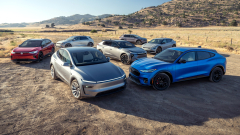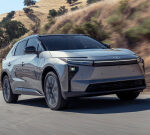The electric SUV market is more competitive than ever. Just a few years ago, the Tesla Model Y stood alone in the compact EV segment, yet today it’s joined by eight other nameplates vying for attention, as nearly every mainstream automaker now has a contender in a segment that’s still rapidly growing despite the headwinds EVs face.
With more options than ever, picking the right electric SUV can be tricky, but that’s where we come in. We’re here to help you decide which one fits your needs. Here, we compare seven of the most popular EVs of 2025: the Model Y, Hyundai Ioniq 5, Kia EV6, Toyota bZ, Ford Mustang Mach-E, Chevrolet Equinox EV, and Volkswagen ID4. Nissan declined to send an Ariya and we elected not to bring a Subaru Solterra (a mechanical twin of the Toyota) because the refreshed 2026 model wasn’t available. To find our winner, we evaluated their performance, range, charging, handling, and value to see which one delivers the most compelling combination.
We asked automakers to send dual-motor, big-battery versions, but Chevy opted for a front-drive base Equinox with 220 hp and 243 lb-ft of torque. The AWD version, with 300 hp and 355 lb-ft, would’ve been a better match for this group. Power figures for the others ranged from 320 hp for the Korean entries to 397 hp for the Tesla, with torque spanning from 389 lb-ft (Tesla) to 500 lb-ft (Mach-E). The VW ID4 and Toyota bZ offer 335 hp and 338 hp, respectively; neither of these brands provide torque figures.
Range and Charging Times
Beyond slowing sales and shifting government policy, EVs still face a major hurdle: reliable charging infrastructure. As John Bozzella, president and CEO of the Alliance for Automotive Innovation, told us during the filming of “MotorTrend Investigates: America’s EV Problem,” range anxiety and charging access remain top concerns for potential buyers.
We experienced this firsthand during testing in Tehachapi, California, about two hours north of Los Angeles. The fast-charging stations near our hotel—ones we’ve used before—were offline, forcing us to go farther afield. And with the industry transitioning from CCS to Tesla’s NACS port, we had to carry adapters to access both Superchargers and legacy CCS plugs.
To see how far these SUVs go on a single charge, our team range-tested each one via MotorTrend’s Road-Trip Range test, which involves driving at 70 mph constantly on an out-and-back loop that minimizes the effects of elevation change and wind. The Kia EV6 came out on top, covering 266 miles on a single charge and getting quite close to its EPA-rated 295-mile mark. Just behind that sat the Chevrolet Equinox EV, with 262 miles covered. Third place had a tie between the Mustang Mach-E and Tesla Model Y, each delivering 252 miles without stopping to charge. The Hyundai Ioniq 5’s big 20-inch wheels hurt its range, as it covered 234 miles. Sixth and seventh place belong to the Toyota bZ and Volkswagen ID4, respectively. The Toyota covered 222 miles, while the VW only managed 208.
Our fast-charging tests also proved the Kia EV6 was the fastest to replenish its battery pack, adding 160 miles in 15 minutes at a 350-kWh charger. Its counterpart, the Ioniq 5, added 138 miles in the same time. The Model Y was just behind at 133 miles, while the Toyota added 115. The ID4 beat the Chevy and Ford with 103 miles added, while the Mach-E and Equinox EV basically tied at 95 and 94 miles.
On the Road
How fast you can charge and how long you can drive is one thing, but how the vehicle feels while driving should be a key consideration when making a buying decision. Is it comfortable? Do you feel confident in its handling? Are the controls easy to find and use? To determine which EV aced these factors, we drove every model on the 27-mile loop that we use for our Car and SUV Of The Year events, which includes a mix of city streets, canyon roads, highways, and railroad crossings.
Despite most of the group having similar power numbers, each had different personalities behind the wheel. The Mach-E is by far the most fun to drive, with a character that actually feels connected, however faintly, to the traditional Mustang. In a time when EVs are often criticized for lacking personality, the Mach-E stands out with its smooth torque delivery, good lateral grip, and confident body control.
You might think the Korean duo would drive identically given they share a platform and powertrain, but the EV6 has a sportier vibe. Its steering is a bit tighter, and its suspension is firmer but not uncomfortable. The Ioniq was the most comfortable of the entire group, with a placid ride and few vibrations reaching the cabin.
Tesla gets the award for most improved. The refreshed Model Y’s retuned suspension delivers a settled and comfortable experience, a far cry from the brittle, overly stiff ride of previous versions. Its steering is notably quick and heavy in this septet, but not so much that you get fatigued.
The Toyota bZ rides well, and its powertrain has plenty of oomph, but its loud tires and lack of one-pedal driving had the judges scratching their heads. Similarly, judges were disappointed in the ID4 having only one brake regeneration setting and no one-pedal mode. The VW’s sporty driving dynamics were praised, however.
The Equinox EV rides relatively well and does a good job damping vibrations, but being front-wheel-drive, it struggled with torque steer. (Despite having the least power in our group, it sends more torque to the front axle than any other.) The lack of driven wheels out back also limited its handling prowess against the field.
Inside
With their large battery packs all stowed beneath the floor, all these EVs offer roomy cabins. Tesla’s rear seats impressed most of our judges, thanks to a dedicated screen for streaming Netflix, YouTube, and Twitch; powered folding seats; a separate rear A/C zone; and the most rear legroom in the group.
But the Model Y also showed clear signs of cost-cutting. It was the only SUV without a sunroof cover—an issue in any region that gets a lot of sun—and had just one USB port up front, though it does include dual wireless chargers like the Toyota. And watching that rear screen, which is mounted down low, can be tough on your neck after a while.
The Ioniq 5’s cabin stood out for its well-executed layout with clearly labeled buttons that balanced physical and digital controls. The Kia EV6, meanwhile, frustrated judges with its switchable climate/audio control. Using the same knob for both functions required toggling between modes, a quirk we hoped would disappear with its recent refresh.
The Mach-E’s large vertical screen earned praise for its simplicity, but judges disliked having to glance far down to adjust the temperature. A redesigned center console this year moves the shifter to the steering column, freeing up plenty of space and making the interior even more practical. We also like the small screen near the steering wheel for key information, as vehicles with only one display, like the Tesla, require you to move your eyes farther away from straight ahead.
The Toyota bZ’s driving position was unpopular. Its small steering wheel and screen placed above—rather than behind—the rim made some judges feel cramped, while the wheel blocked part of the display for others.
The Equinox EV got points for its Camaro-inspired air vents, which add flair to an otherwise plain interior. Its wide dual screens look impressive, but the lack of Apple CarPlay and Android Auto frustrated nearly everyone. Although GM offers built-in Google Maps and downloadable apps like Spotify, the experience still falls short of what most buyers expect in terms of user-friendliness.
As for the ID4, our judges missed having a volume knob but appreciated its large driver display. VW’s infotainment has improved, yet it still lagged in responsiveness, and there’s no place to rest a hand while operating it. We’re also not huge fans of operating all four windows via just two switches or using capacitive slider controls for things like volume and temperature.
Value
Value matters. It’s not just about price but also what you get for it—features, materials, tech, overall quality, and satisfaction. Although sticker price does sway many decisions, it’s only part of the equation.
At $34,995, the Equinox EV was by far the least expensive in the group, but it was also the most sparsely equipped. It lacked all-wheel drive, dual-zone A/C, and power, leather, or heat for any of its seats. Still, every Equinox comes with an 85-kWh battery and a cabin fit for four. That makes the LT trim especially compelling compared to other sub-$40,000 EVs like the Hyundai Kona, Kia Niro, and Nissan Leaf.
The mechanically similar Kia EV6 and Hyundai Ioniq 5 diverged in pricing. The EV6 Wind rang in at $56,435, while the Ioniq 5 Limited cost $61,025—second highest in the group. The Ioniq had more equipment, but the Kia offered stronger value with comparable features, provided you can live with smaller wheels and no sunroof. For Hyundai, long known for undercutting rivals, the value story felt a little off this time.
At $58,670, the Ford Mustang Mach-E Premium brought a lot to the table: a B&O sound system, 360-degree camera, heated and ventilated seats, and Ford’s BlueCruise hands-free driving tech. The Mach-E and Model Y were also the only two with usable frunks.
The ID4’s $59,870 price tag felt steep for what it delivered. It’s well equipped, but its cabin materials lagged the rest of group’s, and we’re still baffled by its lack of individual window switches. It was also the only vehicle here that couldn’t use Tesla Superchargers—a fix VW has said is coming, without providing a timeline.
The Model Y topped the group at $63,630, though $8,000 of that was for the Full Self-Driving (Supervised) option. Without it, the value improves. Judges called out Tesla’s cabin cost-cutting—like the missing sunroof shade—but much of its tech is still at or near the front of the pack.
Like the Equinox, the 2026 Toyota bZ offers fantastic value. Starting at $36,350, the bZ XLE with a smaller battery and a single motor delivers an EPA-rated 236 miles. But upgrading to the Limited AWD with the optional JBL audio system, like the one we tested, sets you back $47,330—not bad when you compare it to other models in this group. If you can live with the Toyota’s middling real-world range, it’s a good way to save $10,000 over some of the competitors.
Safety
Automakers are investing heavily in vehicle safety—not just through airbags and structural strength but also by adding advanced driver assistance systems (ADAS). Some, such as Tesla and Ford, even offer hands-free driving on certain roads, where the car temporarily takes over while the driver must remain attentive.
Ford’s BlueCruise worked exceptionally well in our testing. Judges praised its clear alerts and messaging when the system was ready and when it was time to retake control. The Mach-E stayed centered in its lane and handled automatic lane changes (which also had clear messages) smoothly. Most important, it made us feel safe.
Tesla





